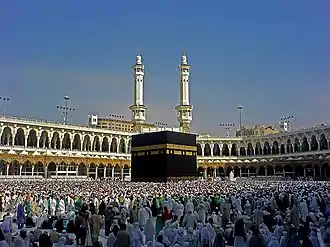Rak'a
A Rak'ah (Arabic: ركعة rakʿah, pronounced [ˈrakʕah]; plural: ركعات rakaʿāt) is a single iteration of prescribed movements and supplications performed by Muslims as part of the prescribed obligatory prayer known as salah.[1] Each of the five daily prayers observed by Muslims consists of a number of raka'at.[1]
| Part of a series on |
| Islamic jurisprudence (fiqh) |
|---|
| Islamic studies |
Procedure
After washing for prayer by performing the ritual ablution, a believer must renew their innermost intention, thus purifying their prayer for the sake of Allah. An intention Niyyah is not to be said verbally but rather it is made in the heart; but can also be said verbally alongside the intention in the heart. Example: you intended in your heart to pray 4 Units (Rakahs) for you start your prayer.[1]
The raka'ah begins when the worshipper initiates the salah with the words "Allah is The Greatest", (Allah-Hu-Akbar) this is known in Arabic as the Takbir (lit. 'the Glorification of God').[1] Takbir must be said at the start of the Salah or the prayer is invalidated.[1] The individual will observe the standing position while reciting the "Dua al istiftah" followed by the opening chapter of the Qur'an (Al-Fatiha) (Note: reciting the Al-Fatiha is a pillar of prayer.[1] If one forgets to say the Al-Fatiha or makes a major mistake in its Tajweed, then they must redo the prayer from the start) followed by a personal selection of chosen verses or chapters which the worshippers are free to choose to recite for themselves.
The second part of the raka'ah involves the worshipper making another Takbir then bowing to a 90 degree angle, placing their hands on their knees with their feet kept shoulder-width apart, eyes are meant to be focused in between you feet or around the area and bowing in humble submission as if awaiting God's command. During this position the words, "Glory be to Allah the most Magnificent" are uttered silently as a form of ritual praise.[1]
The third movement of the raka'ah is to return from bowing to the standing position before, with the praise of Allah on your tongue, descending into full prostration on the ground.[1]
In prostration, the worshipper's forehead and nose is flatly placed on the floor with the palm of their hands placed shoulder-width apart to the right and left of their ears.[1]
During this position the words, "Glory be to Allah the Almighty" are repeated with contemplation as a form of ritual praise. The Islamic prophet Muhammad taught his disciples that "the closest a subject gets to God is when in prostration".[1]
The fourth movement is for the worshipper to return from prostration into a sitting position with their legs folded flatly under their body.[1]
This concludes one unit of prayer known in Arabic as a raka'ah and would be followed by either standing up for a second raka'ah if the prayer requires it or by proceeding to end the salah with taslim.[1]
Although not part of a single raka'ah, the conclusion of the salah takes place in the sitting position.[2][1]
Daily prayers
The five daily prayers for sunnites are each performed with a number of obligatory Rak'ats (called fard).
- The Fajr prayer (dawn prayer) has 2 Rak'at.
- The Zuhr prayer (midday or early afternoon prayer) has 4 Rak'at.
- The Asr prayer (late afternoon prayer) has 4 Rak'at.
- The Maghrib prayer (dusk prayer) has 3 Rak'at.
- The Isha prayer (night prayer) has 4 Rak'at.
There is a slight variation of the midday prayer on Fridays, if it is read as part of a congregational prayer called the Friday prayer (Jummah prayer).[lower-alpha 1] The Friday prayer is preceded by a sermon, usually delivered by the imam. The prayer units remain the same.
See also
Notes
- Only performed in the first rakat of the prayer and only performed by some schools.
- Only first half of the Tashahhud is recited in the second rakat in a 4- or 3-rakat prayer, e.g. the afternoon prayer or the evening prayer, but all of it is recited in the last rakat of any prayer.
- Only performed in the last rakat of a prayer.
Endnotes
- Attendance at a mosque is optional for women and they can choose to pray the midday prayer at home.
References
- "Rakat - The nature of God - GCSE Religious Studies Revision - WJEC". BBC Bitesize. Retrieved 2021-12-07.
- Taslim
